![]()
![]()
![]()
Use LEFT and RIGHT arrow keys to navigate between flashcards;
Use UP and DOWN arrow keys to flip the card;
H to show hint;
A reads text to speech;
40 Cards in this Set
- Front
- Back
|
Are CIs and HTs about variances (or standard deviations) considered risky compared to CIs and HTs about means? |
yes |
|
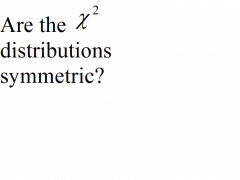
|
no |
|
|
Are the F distributions symmetric? |
no |
|
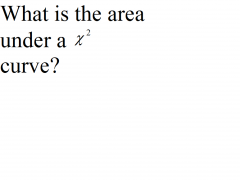
|
1 |
|
|
What is the area under a F curve? |
1 |
|

|

|
|
|
When comparing variances, what arithmetic operation is used? |
division |
|
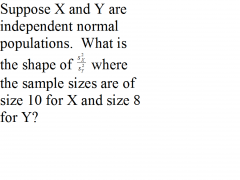
|
F with 9 degrees of freedom on the top and 7 degrees of freedom on the bottom |
|
|
In a continuous distribution the mean is the area under what curve? |
xp(x) |
|
|
The area under xp(x) gives what value in the continuous case? |
the mean |
|
|
The area under p(x) gives what value in the continuous case? |
one |
|
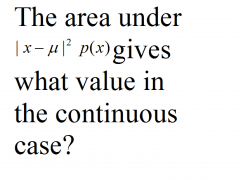
|
the variance |
|
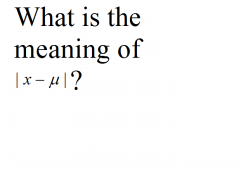
|
how far a piece of data is from the mean |
|

|
on average how far the data is from the mean |
|
|
Is variance an average? |
yes |
|
|
Variance is the average of what? |
the squares of how far the data are from the mean |
|
|
Describe what the standard deviation is in words. |
the square root of the average of the squares of how far the data are from the mean |
|
|
If a set of data is normal with a mean of 40 and a standard deviation of 8, what shape will the data have if each piece of data has 40 subtracted and then that result divided by 8? |
normal |
|
|
If a set of data is normal with a mean of 40 and a standard deviation of 8, what will be the mean of the data have if each piece of data has 40 subtracted and then that result divided by 8? |
0 |
|
|
If a set of data is normal with a mean of 40 and a standard deviation of 8, what will be the standard deviation of the data have if each piece of data has 40 subtracted and then that result divided by 8? |
1 |
|
|
We came up with the formula for P(A | B) by taking a sports team and making a fraction for P(W | H) and the top of the fraction represented what? |
how many games were both wins and at home |
|
|
We came up with the formula for P(A | B) by taking a sports team and making a fraction for P(W | H) and the bottom of the fraction represented what? |
how many games were at home |
|
|
How can you turn “how many” into “probability”? |
divide by total |
|
|
True or False: P(A and B) and P(A | B) are just two ways to write the same thing? |
F |
|
|
True of False: P(A | B) is the same as P(B | A)? |
F |
|
|
Explain what P(A | B) = P(A) means in everyday terms. |
B has no effect on the chances of A |
|
|
If P(A | B) = P(A) as well as P(B | A) = P(B) we say that A and B have what property? |
independent |
|
|
If X and Y are independent then P(X | Y) = what? |
P(X) |
|
|
To figure out how many ways a multi-step process can be done you do what? |
multiple how many choices at each step |
|
|
How many ways can n things can be arranged in a row? |
n! |
|
|
When finding out how many ways to pick 6 numbers from 42 numbers in a lottery in which order does not matter we first (incorrectly) came up with what? We realized that each outcome was being counted 6! times? So we divided by this number and came up with the correct answer of (42)(41)(40)(39)(38)(37)/6! |
(42)(41)(40)(39)(38)(37) |
|
|
When finding out how many ways to pick 6 numbers from 42 numbers in a lottery in which order does not matter we first (incorrectly) came up with (42)(41)(40)(39)(38)(37). We realized that each outcome was being counted how many times? So we divided by this number and came up with the correct answer of (42)(41)(40)(39)(38)(37)/6! |
6! |
|
|
When finding out how many ways to pick 6 numbers from 42 numbers in a lottery in which order does not matter we first (incorrectly) came up with (42)(41)(40)(39)(38)(37). We realized that each outcome was being counted 6! times. So we divided by this number and came up with the correct answer of what? |
(42)(41)(40)(39)(38)(37)/6! |
|
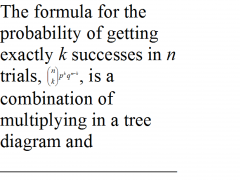
|
lottery formula |
|

|
multiplying in a tree diagram |
|
|
When using the normal to approximate the binomial the probability of exactly 6 successes is approximately the area from _____ to ____, and this is why we add or subtract .5 when using the normal approximation for the binomial. |
5.5 to 6.5 |
|
|
In the binomial setting what does n – k represent? |
number of failures |
|

|
how many ways you can get k successes in n trials |
|
|
In the binomial setting what does np represent? |
average number of successes |
|
|
In the binomial setting what does nq represent? |
average number of failures |

